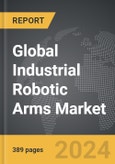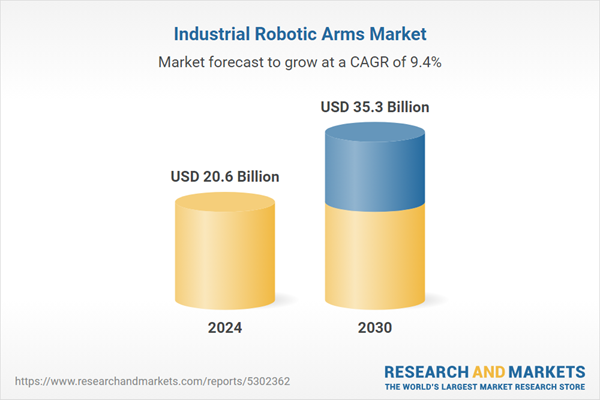The global market for Industrial Robotic Arms was valued at US$20.6 Billion in 2024 and is projected to reach US$35.3 Billion by 2030, growing at a CAGR of 9.4% from 2024 to 2030. This comprehensive report provides an in-depth analysis of market trends, drivers, and forecasts, helping you make informed business decisions. The report includes the most recent global tariff developments and how they impact the Industrial Robotic Arms market.
The growth in the industrial robotic arms market is driven by several factors. The increasing demand for automation to enhance productivity and reduce labor costs is a primary driver. As global competition intensifies, manufacturers are compelled to adopt robotic arms to maintain an edge. The rise of smart factories and the adoption of Industry 4.0 technologies are also significant contributors, as they facilitate the integration of robotic systems into existing production lines. Moreover, the ongoing labor shortages in key manufacturing regions have accelerated the shift towards automation. Consumer behavior trends, such as the demand for high-quality, customized products, necessitate flexible manufacturing solutions that robotic arms provide. Furthermore, advancements in AI and machine learning have expanded the capabilities of robotic arms, enabling them to perform more complex tasks and adapt to changing production requirements. These factors collectively underscore the robust growth and dynamic evolution of the industrial robotic arms market.
Technological advancements in industrial robotic arms have been rapid, with significant improvements in areas such as payload capacity, speed, and precision. Collaborative robots, or cobots, represent a major innovation, designed to work alongside humans safely without the need for extensive safety barriers. These robots are equipped with advanced safety features like force sensing and machine learning algorithms that enable them to recognize and react to human presence. Additionally, the integration of IoT (Internet of Things) and Industry 4.0 principles has enhanced the functionality of robotic arms, allowing for predictive maintenance and seamless communication across the production floor. This interconnectedness ensures minimal downtime and optimal performance, further cementing the role of robotic arms in modern manufacturing processes.
Segments: Application (Automotive Application, Electrical / Electronics Application, Metal & Heavy Machinery Application, Chemicals Application, Food & Beverage Application, Other Applications).
Geographic Regions/Countries: World; USA; Canada; Japan; China; Europe; France; Germany; Italy; UK; Spain; Russia; Rest of Europe; Asia-Pacific; India; South Korea; Rest of Asia-Pacific; Latin America; Brazil; Mexico; Rest of Latin America; Middle East; Africa.
The analysts continuously track trade developments worldwide, drawing insights from leading global economists and over 200 industry and policy institutions, including think tanks, trade organizations, and national economic advisory bodies. This intelligence is integrated into forecasting models to provide timely, data-driven analysis of emerging risks and opportunities.
Global Industrial Robotic Arms Market - Key Trends & Drivers Summarized
Industrial robotic arms have revolutionized the manufacturing sector by providing unparalleled precision, efficiency, and flexibility in various applications. These robotic systems, equipped with multiple joints and axes, mimic the movements of a human arm, enabling them to perform complex tasks such as welding, painting, assembly, and material handling with high accuracy. Modern industrial robotic arms are often integrated with advanced sensors and artificial intelligence (AI), allowing them to adapt to dynamic environments and perform quality control in real-time. This level of sophistication has made them indispensable in industries such as automotive, electronics, aerospace, and pharmaceuticals, where consistency and reliability are paramount.The growth in the industrial robotic arms market is driven by several factors. The increasing demand for automation to enhance productivity and reduce labor costs is a primary driver. As global competition intensifies, manufacturers are compelled to adopt robotic arms to maintain an edge. The rise of smart factories and the adoption of Industry 4.0 technologies are also significant contributors, as they facilitate the integration of robotic systems into existing production lines. Moreover, the ongoing labor shortages in key manufacturing regions have accelerated the shift towards automation. Consumer behavior trends, such as the demand for high-quality, customized products, necessitate flexible manufacturing solutions that robotic arms provide. Furthermore, advancements in AI and machine learning have expanded the capabilities of robotic arms, enabling them to perform more complex tasks and adapt to changing production requirements. These factors collectively underscore the robust growth and dynamic evolution of the industrial robotic arms market.
Technological advancements in industrial robotic arms have been rapid, with significant improvements in areas such as payload capacity, speed, and precision. Collaborative robots, or cobots, represent a major innovation, designed to work alongside humans safely without the need for extensive safety barriers. These robots are equipped with advanced safety features like force sensing and machine learning algorithms that enable them to recognize and react to human presence. Additionally, the integration of IoT (Internet of Things) and Industry 4.0 principles has enhanced the functionality of robotic arms, allowing for predictive maintenance and seamless communication across the production floor. This interconnectedness ensures minimal downtime and optimal performance, further cementing the role of robotic arms in modern manufacturing processes.
Report Scope
The report analyzes the Industrial Robotic Arms market, presented in terms of units. The analysis covers the key segments and geographic regions outlined below.Segments: Application (Automotive Application, Electrical / Electronics Application, Metal & Heavy Machinery Application, Chemicals Application, Food & Beverage Application, Other Applications).
Geographic Regions/Countries: World; USA; Canada; Japan; China; Europe; France; Germany; Italy; UK; Spain; Russia; Rest of Europe; Asia-Pacific; India; South Korea; Rest of Asia-Pacific; Latin America; Brazil; Mexico; Rest of Latin America; Middle East; Africa.
Key Insights:
- Market Growth: Understand the significant growth trajectory of the Automotive Application segment, which is expected to reach US$11.0 Billion by 2030 with a CAGR of a 9.4%. The Electrical / Electronics Application segment is also set to grow at 10.2% CAGR over the analysis period.
- Regional Analysis: Gain insights into the U.S. market, valued at $2.6 Billion in 2024, and China, forecasted to grow at an impressive 10.9% CAGR to reach $11.3 Billion by 2030. Discover growth trends in other key regions, including Japan, Canada, Germany, and the Asia-Pacific.
Why You Should Buy This Report:
- Detailed Market Analysis: Access a thorough analysis of the Global Industrial Robotic Arms Market, covering all major geographic regions and market segments.
- Competitive Insights: Get an overview of the competitive landscape, including the market presence of major players across different geographies.
- Future Trends and Drivers: Understand the key trends and drivers shaping the future of the Global Industrial Robotic Arms Market.
- Actionable Insights: Benefit from actionable insights that can help you identify new revenue opportunities and make strategic business decisions.
Key Questions Answered:
- How is the Global Industrial Robotic Arms Market expected to evolve by 2030?
- What are the main drivers and restraints affecting the market?
- Which market segments will grow the most over the forecast period?
- How will market shares for different regions and segments change by 2030?
- Who are the leading players in the market, and what are their prospects?
Report Features:
- Comprehensive Market Data: Independent analysis of annual sales and market forecasts in US$ Million from 2024 to 2030.
- In-Depth Regional Analysis: Detailed insights into key markets, including the U.S., China, Japan, Canada, Europe, Asia-Pacific, Latin America, Middle East, and Africa.
- Company Profiles: Coverage of players such as ABB Ltd., DENSO Corporation, Dobot.cc, Epson America, Inc., Fanuc Corporation and more.
- Complimentary Updates: Receive free report updates for one year to keep you informed of the latest market developments.
Some of the 105 companies featured in this Industrial Robotic Arms market report include:
- ABB Ltd.
- DENSO Corporation
- Dobot.cc
- Epson America, Inc.
- Fanuc Corporation
- Flexiv Robotics Inc.
- Gridbots Technologies Private Limited
- Kawasaki Heavy Industries, Ltd.
- KUKA Robotics Corporation
- Mitsubishi Electric Corporation
- NACHI-FUJIKOSHI CORP.
- OMRON Corporation
- Universal Robots A/S
- Yaskawa Europe GmbH
Tariff Impact Analysis: Key Insights for 2025
Global tariff negotiations across 180+ countries are reshaping supply chains, costs, and competitiveness. This report reflects the latest developments as of April 2025 and incorporates forward-looking insights into the market outlook.The analysts continuously track trade developments worldwide, drawing insights from leading global economists and over 200 industry and policy institutions, including think tanks, trade organizations, and national economic advisory bodies. This intelligence is integrated into forecasting models to provide timely, data-driven analysis of emerging risks and opportunities.
What’s Included in This Edition:
- Tariff-adjusted market forecasts by region and segment
- Analysis of cost and supply chain implications by sourcing and trade exposure
- Strategic insights into geographic shifts
Buyers receive a free July 2025 update with:
- Finalized tariff impacts and new trade agreement effects
- Updated projections reflecting global sourcing and cost shifts
- Expanded country-specific coverage across the industry
Table of Contents
I. METHODOLOGYII. EXECUTIVE SUMMARY2. FOCUS ON SELECT PLAYERSIII. MARKET ANALYSISINDIASOUTH KOREAREST OF ASIA-PACIFICLATIN AMERICABRAZILMEXICOREST OF LATIN AMERICAMIDDLE EASTAFRICAIV. COMPETITION
1. MARKET OVERVIEW
3. MARKET TRENDS & DRIVERS
4. GLOBAL MARKET PERSPECTIVE
UNITED STATES
CANADA
JAPAN
CHINA
EUROPE
FRANCE
GERMANY
ITALY
UNITED KINGDOM
SPAIN
RUSSIA
REST OF EUROPE
ASIA-PACIFIC
Companies Mentioned (Partial List)
A selection of companies mentioned in this report includes, but is not limited to:
- ABB Ltd.
- DENSO Corporation
- Dobot.cc
- Epson America, Inc.
- Fanuc Corporation
- Flexiv Robotics Inc.
- Gridbots Technologies Private Limited
- Kawasaki Heavy Industries, Ltd.
- KUKA Robotics Corporation
- Mitsubishi Electric Corporation
- NACHI-FUJIKOSHI CORP.
- OMRON Corporation
- Universal Robots A/S
- Yaskawa Europe GmbH
Table Information
| Report Attribute | Details |
|---|---|
| No. of Pages | 408 |
| Published | April 2025 |
| Forecast Period | 2024 - 2030 |
| Estimated Market Value ( USD | $ 20.6 Billion |
| Forecasted Market Value ( USD | $ 35.3 Billion |
| Compound Annual Growth Rate | 9.4% |
| Regions Covered | Global |









